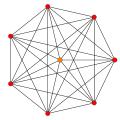Top Qs
Timeline
Chat
Perspective
9-simplex
Convex regular 9-polytope From Wikipedia, the free encyclopedia
Remove ads
In geometry, a 9-simplex is a self-dual regular 9-polytope. It has 10 vertices, 45 edges, 120 triangle faces, 210 tetrahedral cells, 252 5-cell 4-faces, 210 5-simplex 5-faces, 120 6-simplex 6-faces, 45 7-simplex 7-faces, and 10 8-simplex 8-faces. Its dihedral angle is cos−1(1/9), or approximately 83.62°.
This article includes a list of general references, but it lacks sufficient corresponding inline citations. (August 2025) |
It can also be called a decayotton, or deca-9-tope, as a 10-facetted polytope in 9-dimensions. The name decayotton is derived from deca for ten facets in Greek and yotta (a variation of "oct" for eight), having 8-dimensional facets, and -on.
Jonathan Bowers gives it acronym day.[1]
Remove ads
Coordinates
Summarize
Perspective
The Cartesian coordinates of the vertices of an origin-centered regular decayotton having edge length 2 are:
More simply, the vertices of the 9-simplex can be positioned in 10-space as permutations of (0,0,0,0,0,0,0,0,0,1). These are the vertices of one Facet of the 10-orthoplex.
Remove ads
Images
References
External links
Wikiwand - on
Seamless Wikipedia browsing. On steroids.
Remove ads


















